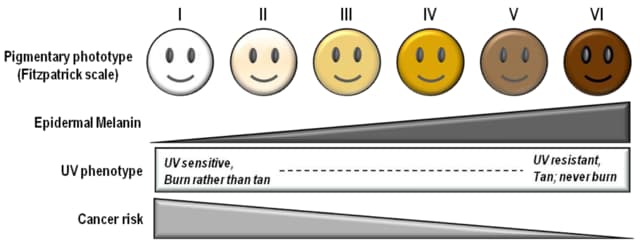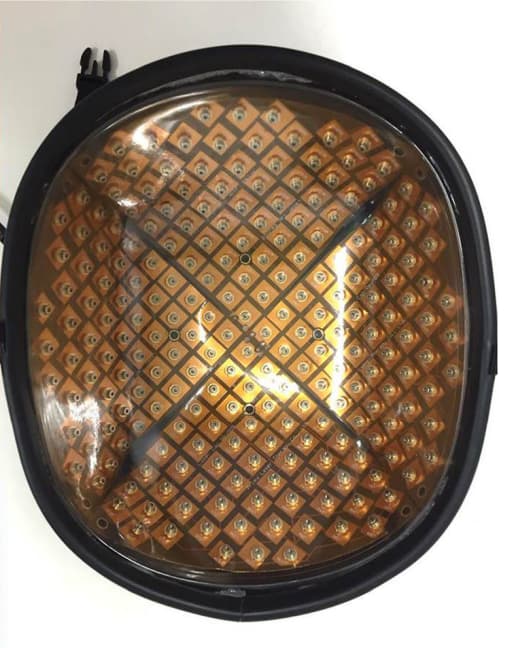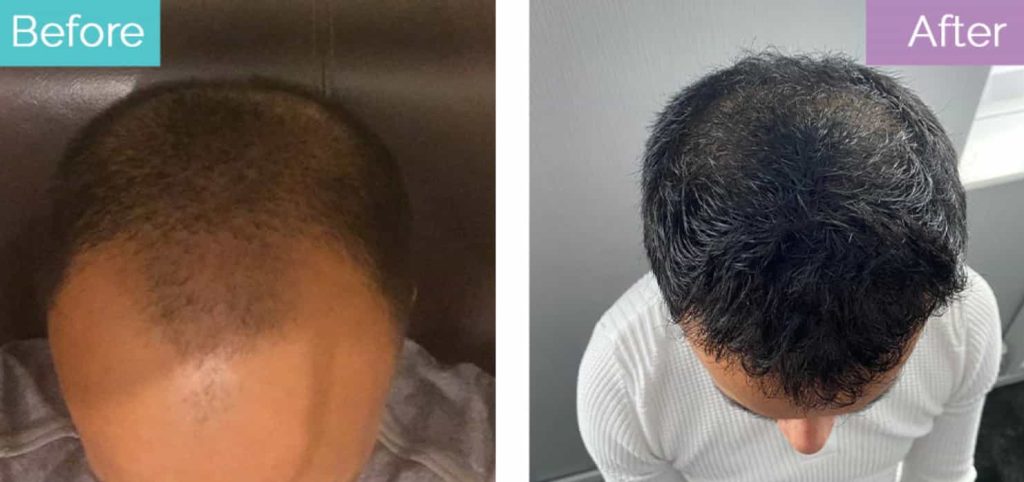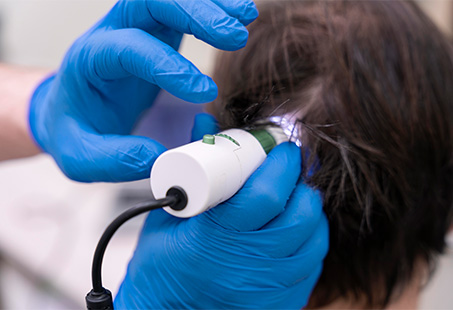Laser caps, combs, helmets, and bands; all kinds of products are flooding the hair loss market. They are almost reminiscent of the time of the industrial revolution when thermocaps and glass combs were marketed for treating hair loss.
However, we have come a long way since. If you don’t provide some scientific evidence to support your claims, you will have trouble convincing people. Laser hair growth treatments have stirred up a commotion for that very reason.
Companies selling these products claim that it is a safe, non-invasive procedure that can improve blood circulation in the scalp. This, in turn, promotes hair growth.
While there’s some research on the effectiveness of laser hair growth or low level laser therapy (LLLT), there’s not enough evidence to give a clear verdict. In this article, we’ll explore how laser therapy for hair loss actually works.
What Is The History Of Laser Treatment For Hair Growth?
As early as the 1960s, a study inadvertently discovered laser’s hair-growing effect.
Researchers wanted to know if laser beams caused cancer. Mice were used in the study as an animal model.
For this study, the mice were first shaved. And so when they were bombarded with laser, the researchers noticed an improvement in hair growth. The laser did not cause cancer.
Since then, researchers have developed this technology for hair growth.
The HairMax laser comb was the first medical laser device to receive FDA approval for treating male pattern baldness at home in 2007.
On the safety and efficacy of HairMax, a double-blind, sham-device controlled study was published in the Clinical Drug Investigation in 2009.
All 110 participants had male androgenetic alopecia. All the participants who received LLLT showed an improvement in hair density and exhibited better hair growth.
According to this study, the laser makes the hair follicles in the telogen phase enter the anagen phase, thus, effectively delaying their fall. However, it is mere speculation.
How Does Laser Hair Regrowth Work?
There are a few ways in which laser hair therapy allegedly promotes regrowth. These are as follows:
Repairs Cells
Many pieces of research show that laser beams can stimulate the production of lymphocytes and fibroblasts (cells that help in wound healing).
The cell repairing and regenerating function of laser has made it popular in treating wounds in different areas of the body.
A study published in the Photodermatology, Photoimmunology and Photomedicine journal in 2017 showed that near-infrared and red light therapy promotes wound healing, reduces pain and inflammation, and even restores functioning.
It is possible that low level laser hair therapy actually stimulates hair growth in part because it is capable of repairing and regenerating cells.
Increases Supply of Oxygen & Nutrients
Apparently, the laser hair growth devices use “photochemical hair growth stimulation.”
According to DermNet NZ, light is absorbed by an enzyme in the cells. This results in the production of adenosine triphosphate (ATP) (cell’s source of energy) in hair follicles.

This process also results in the release of gas from the cell, which helps in the growth of new blood vessels, delivering more nutrients and oxygen to the hair follicles.
Keep in mind all these explanations of how laser therapy works in promoting hair growth are merely theoretical. We can’t say for sure if this is how laser hair regrowth takes place.
Stimulates Stem Cells
Stem cells are found in the bulge of hair follicles. And your hair cannot regenerate if these stem cells are not activated.
It’s believed that laser treatment for hair works by stimulating these stem cells in the hair follicles. This, in turn, shifts more hair into the growing (anagen) phase.
Additionally, it is believed to lengthen the duration of the anagen phase (which is usually between 2-8 years).
It may also explain why low level laser therapy for hair loss works.
Does Laser Hair Regrowth Treatment Work?
Different researches have shown that laser therapy can stimulate hair regrowth in both men and women. It’s even considered a safe and effective treatment option for androgenetic alopecia.
However, so far, the research on it is quite limited. Even the LLLT’s mechanism of action is not well understood.
Additionally, there’s no standard “power” or wavelength, which is considered the best to stimulate hair growth. While red or near infrared hair growth has proven to be possible, at very high energies, laser can even inhibit hair growth.
Another thing that remains unknown about laser therapy is its treatment time and frequency. In other words, you can’t really predict how long it will take to see results from laser treatments.
You can follow the manufacturer’s instructions on the device that you’re using. However, it won’t guarantee results.
The “Fitzpatrick skin type” scale is another important consideration when it comes to the effectiveness of laser hair restoration.

Darker skin has more melanin, and that’s shown to absorb more laser energy. As a result, laser treatment for hair regrowth becomes less effective that it usually is.
Still, laser therapy can be considered a good adjunct treatment for stimulating hair growth. However, it’s not always going to give you results.
Are The Studies On Laser Hair Regrowth Trustworthy?
There are more random, sham-device controlled studies featuring Oaze, Capillus, iRestore, TopHat655, and Igrow laser devices, among others.
Most of the studies report that laser hair therapy is safe and effective and can promote hair growth. However, the problem is that some studies may have research bias because of their direct association with the industry.
On low level laser therapy, the International Society of Hair Restoration Surgery (ISHRS) says that there’s “a lack of good support from large, well-designed double-blind studies.” Therefore, it takes no official stand on the effectiveness of this treatment to stimulate hair growth.
Moreover, some employ bogus sham devices to make results from laser hair regrowth even more statistically significant. In some cases, the sample and methodology are also somewhat deceptive.
For instance, a study backing Capillus was done only on women suffering from female pattern baldness. However, it was generalized so the product could also target male pattern baldness.
This is why results from such studies have to be taken with a grain of salt. That is not to say all the studies aren’t legitimate. However, some of them clearly are.
Another problem with these studies is that the sample sizes are small. Moreover, many studies make use of animal models rather than humans to determine the hair growth effect of lasers.
Still, some of the research about lasers that is unbiased shows promising results from this treatment.
Are Laser Hair Loss Treatments Safe?
In general, low level laser hair therapy is considered safe.
Not surprisingly, most of the research on laser hair growth reported that the participants did not experience any side effects. Of the reported, these are the following:
- Pain
- Tenderness/Warm feeling
- Irritation
- Headache
- Acne
- Temporary hair loss
- Itchiness (pruritus)
- Dry skin
- Skin rash (erythema)
Keep in mind that it can also cause some temporary hair loss at the beginning of the treatment.
It’s important to be aware of all the possible side effects of this treatment, which is why you should consult a medical professional before.
How Long Does It Take To See Results From LLLT Therapy?
It depends on the device that you’re using. It may take 3-5 months for a laser hair growth treatment to show results.

According to DermNet NZ, usually, you have to use the laser hair devices 2-3 times a week for 8-15 minutes.
Keep in mind it’s not known when (or if) you’ll see the results from low-level laser therapy.
It may depend on the device that you’re using. The closer it is to your scalp, the better. For this reason, combs are considered the best.
If you buy a premium product that has more diodes and provides greater coverage, you might be promised “quicker” results. But again, bear in mind it’s not known at what energy laser devices work best.
Does Laser Hair Growth Treatment Work for Everyone?
According to the ISHRS, no.
If the person’s hair follicles don’t absorb the photons or react to them in the desired manner, nothing will happen. They also state that this treatment is more effective when used with other hair loss treatments (minoxidil/finasteride).
Moreover, although the research mentioned above states that it works well to replenish hair follicles or treat female/male pattern hair loss, chances are it won’t help much if the hair loss is extensive.
One look at the Amazon reviews for these products, and you’ll find more than just a few disgruntled buyers. People who have truly experienced using it have a completely different story to tell.
Is Laser Hair Regrowth Permanent?
LLLT can stimulate hair growth, but it cannot be said that it gives permanent results. Currently, there’s not enough research on the long-term efficacy of laser devices for hair regrowth.
We can’t say for sure if users will have to keep using the laser product to maintain the results or if the hair loss will resume once they stop using it.
One thing’s for sure, though, that you have to have multiple sessions of it to see any results, if at all.
How Much Does Laser Hair Regrowth Cost?
At home laser hair devices can cost you anywhere from £200-£1,200.
It depends on the kind of device that you’re using (and the number of diodes in it). Combs are the cheapest, while caps are the most expensive.
However, instead of buying the device, you can also choose to get treatment sessions at a clinic. Those usually cost £45-£50 in the UK.
According to the UK Health Centre, most clinics recommend 20-30 treatment sessions, which can bring the total to around £1,200. And some clinics also recommend patients buy their own at-home devices for even better results.
You should also keep in mind that LLLT is usually an adjunct treatment. So, you’ll also have to spend money on other treatment options like minoxidil and finasteride for better results.
What Are The Alternatives to Laser Hair Growth?
Before trying any treatment for your hair loss, you should get a diagnosis to determine the root cause.
If a laser hair growth treatment isn’t working for you, you can consider getting platelet-rich plasma (PRP) injections that also work by repairing cells and have a regenerative capacity.
It can also improve blood circulation to the scalp. Many independent researches show promising results from the treatment.
If you’re suffering from androgenetic alopecia, hair transplant surgery can give you permanent results.

Moreover, you don’t have to keep getting hair transplants in Istanbul to maintain the results. Mostly, people need only one procedure to achieve the desired outcome.
Taking time out every day, even for a few minutes, to use a laser hair growth cap or laser hair growth helmet is inconvenient for many people.
Conclusion
A few studies have shown the effectiveness of low level laser therapy for hair growth. However, it is not exactly known how these devices promote hair growth. Some say that they repair damaged hair follicles, while others claim that they increase the supply of oxygen and essential nutrients to the hair cells.
Most of the studies on laser hair growth have limitations because of their bias, methodology, and sample size. People who have used the device don’t report any significant hair growth either. You can try using the devices and try to find out for yourself if they truly do make a difference to the hair growth cycle.
However, keep in mind that some of these are prohibitively expensive, costing hundreds to thousands of pounds. That coupled with the idea that the device might not actually deliver any results is, currently, a huge downside for many people.
Low level laser therapy for hair growth is gaining popularity for treating hair loss. But more research is needed before we can make any definitive conclusions about its efficacy.
Reviewed and Approved by Trichologist Yaprak Yazan


